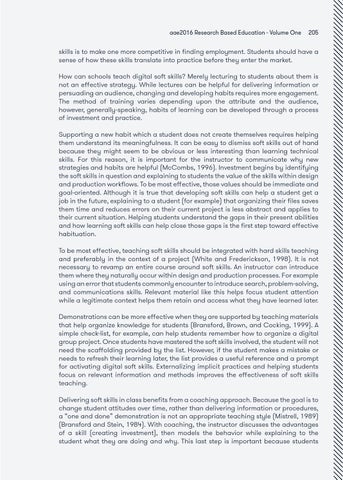aae2016 Research Based Education - Volume One
205
skills is to make one more competitive in finding employment. Students should have a sense of how these skills translate into practice before they enter the market. How can schools teach digital soft skills? Merely lecturing to students about them is not an effective strategy. While lectures can be helpful for delivering information or persuading an audience, changing and developing habits requires more engagement. The method of training varies depending upon the attribute and the audience, however, generally-speaking, habits of learning can be developed through a process of investment and practice. Supporting a new habit which a student does not create themselves requires helping them understand its meaningfulness. It can be easy to dismiss soft skills out of hand because they might seem to be obvious or less interesting than learning technical skills. For this reason, it is important for the instructor to communicate why new strategies and habits are helpful (McCombs, 1996). Investment begins by identifying the soft skills in question and explaining to students the value of the skills within design and production workflows. To be most effective, those values should be immediate and goal-oriented. Although it is true that developing soft skills can help a student get a job in the future, explaining to a student (for example) that organizing their files saves them time and reduces errors on their current project is less abstract and applies to their current situation. Helping students understand the gaps in their present abilities and how learning soft skills can help close those gaps is the first step toward effective habituation. To be most effective, teaching soft skills should be integrated with hard skills teaching and preferably in the context of a project (White and Frederickson, 1998). It is not necessary to revamp an entire course around soft skills. An instructor can introduce them where they naturally occur within design and production processes. For example using an error that students commonly encounter to introduce search, problem-solving, and communications skills. Relevant material like this helps focus student attention while a legitimate context helps them retain and access what they have learned later. Demonstrations can be more effective when they are supported by teaching materials that help organize knowledge for students (Bransford, Brown, and Cocking, 1999). A simple check-list, for example, can help students remember how to organize a digital group project. Once students have mastered the soft skills involved, the student will not need the scaffolding provided by the list. However, if the student makes a mistake or needs to refresh their learning later, the list provides a useful reference and a prompt for activating digital soft skills. Externalizing implicit practices and helping students focus on relevant information and methods improves the effectiveness of soft skills teaching. Delivering soft skills in class benefits from a coaching approach. Because the goal is to change student attitudes over time, rather than delivering information or procedures, a “one and done� demonstration is not an appropriate teaching style (Mistrell, 1989) (Bransford and Stein, 1984). With coaching, the instructor discusses the advantages of a skill (creating investment), then models the behavior while explaining to the student what they are doing and why. This last step is important because students
